Power Rankings: Dems expected to cut into GOP lead for House
Bill Hemmer reports on key shifts in midterm predictions.
Republicans are expected to win the House this November but on a slimmer margin than previously forecast, while neither party can yet claim a majority in the Senate. In this edition of the Fox News Power Rankings, the GOP suffers a net loss of six seats in the House as polling improves for the Democrats, plus shifts in almost a dozen Senate and governor's races.
House: Republicans forecast to win a majority of 2 to 30 seats; fewer than anticipated in July
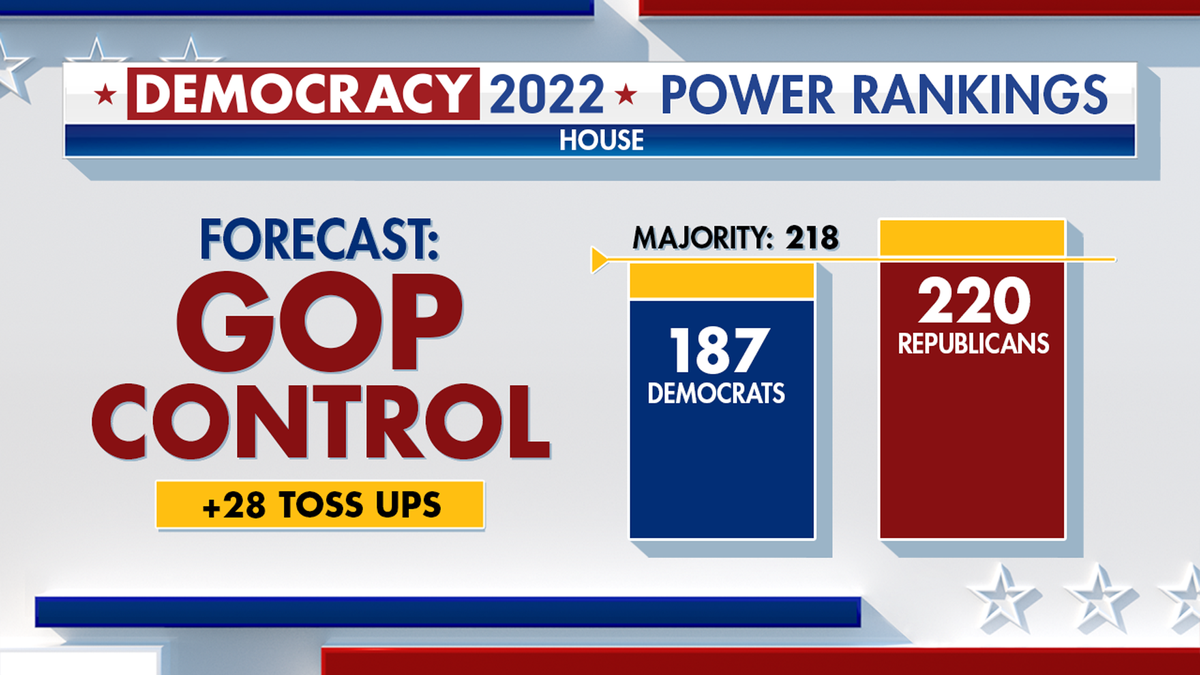
Republicans are predicted to take control of the House in November. (Fox News)
Our latest rankings still expect Republicans to win the House, now with a majority of 2 to 30 seats (a total of 220 to 248 seats). The exact number of seats depends on how many toss-up districts are won by Democrats and Republicans. If GOP candidates win half of those highly competitive districts, then the party would govern with a comfortable 16-seat majority (234 seats). Make no mistake, the national environment looks good for conservatives.
However, there are probably fewer seats in play for the GOP than there were in July. In the last rankings, Republicans were expected to take a 22-seat majority (again, assuming they win half the toss-up races). With a new estimated majority of 16 seats, the GOP net gain has shrunk by six over the last six weeks.
In those same weeks, Democrats have enjoyed a polling boost. The latest national Fox News Poll showed the Democrats and GOP tied at 41% each on the "generic ballot" question, which asked registered voters whether they would vote for the Democratic or Republican candidate in their district. Several other high-quality polls are showing similar shifts. Throughout July and August, gas prices have eased a little; the Supreme Court’s abortion ruling remained a top story; and Democrats took victory laps over computer chip manufacturing legislation and a climate, health care and tax package. It all has amounted to a late-summer swell for the left.
President Biden’s approval rating has also ticked up a few points (the president signed all those bills into law, after all). In the latest Fox News poll, 42% of voters approved of Biden while 58% disapproved, reducing a 19-point deficit in July to 16 points now. Of course, Biden’s approval rating is still relatively low at this point of his presidency, and therefore has remained a major drag on the Democrats' prospects.
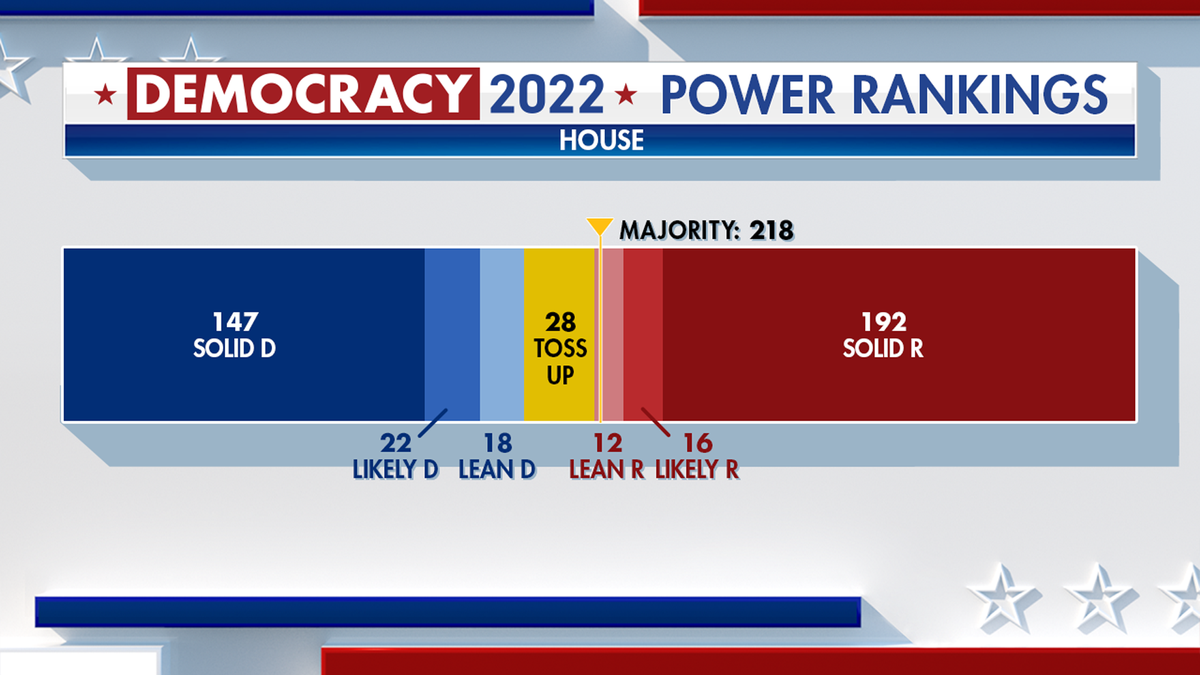
Chart shows big GOP lead for the House. (Fox News)
Together, the congressional generic ballot and presidential approval numbers are telling an interesting story. On the congressional side, Democrats and Republicans are tied up. On the presidential side, Biden is down in the dumps. Both figures have predictive value, but given this split, congressional polling is likely to have the most direct effect on the outcome. As a result, this forecast more closely reflects congressional polling than other data points (overall, the rankings take into account a wide variety of factors).
Democrats have another cause for cautious optimism. Several special elections have taken place since the July abortion ruling, and Democratic candidates have outperformed Biden’s 2020 margins in each. This column previously mentioned the race for Nebraska’s 1st congressional district, which took place just days after the abortion ruling. In that race, the Democrats' margin increased by 5.7 points compared to Biden’s district result in the last presidential election. Two weeks ago, voters in Minnesota delivered a narrow win to Republican Rep. Brad Finstad, with Democrat Jeff Ettinger up 3.2 points versus Biden in 2020. (A third special election in Alaska was less instructive.) Precinct-level results in the Minnesota race revealed that Ettinger mostly outperformed in suburban areas, where opposition to abortion restrictions is generally more intense.

Chart forecasts Republican control of the House. (Fox News)
These factors explain why Democrats have made gains in the latest rankings, particularly in suburban races. Starting in Colorado, two districts spanning the Denver suburbs have shifted leftward. Those are the 7th and 8th districts, which shift to Lean D and Toss Up, respectively. Moving to the east, the 13th district in North Carolina, where pro-Trump former college football player Bo Hines is seeking to enter the House, shifts from Lean R to Toss Up. In neighboring Virginia, centrist Democrat Abigail Spanberger sees her wealthy, exurban 7th district move from Toss Up to Lean D. In Pennsylvania, an open seat in the 17th district, which is home to suburban areas north and west of Pittsburgh, shifts from Lean R to Toss Up.
Finally, recent primary contests have revealed more about candidate strength. These rankings take into account nonpartisan primary results in both California and Washington. They also consider the latest regular primary contests. Most notably, Michigan’s 3rd district moves from Lean R to Toss Up after the Democrats' meddling helped ensure that moderate Republican Peter Meijer lost his primary. Meijer recently said Democrats were "bewilderingly hypocritical" for spending ad dollars to boost his far-right opponent, who reportedly has questioned the results of the 2020 election. In any case, the race is looking better for the Democrats than it did before the primary.
Senate: Iowa and Missouri switch places, and Washington moves back into "solid" territory.
On the Senate side of the Capitol, the headline numbers remain as they were in July. Democrats can expect 46 seats, while Republicans can expect 49 seats. There are another five Toss Up races left on the board. In other words, neither party has enough seats in their columns for a majority (Democrats only need 50 to retain the Senate because of Vice President Kamala Harris’ tie-breaking vote; Republicans need 51 to flip it). The GOP has a slight advantage because the party can win fewer Toss Up races and still take the majority.
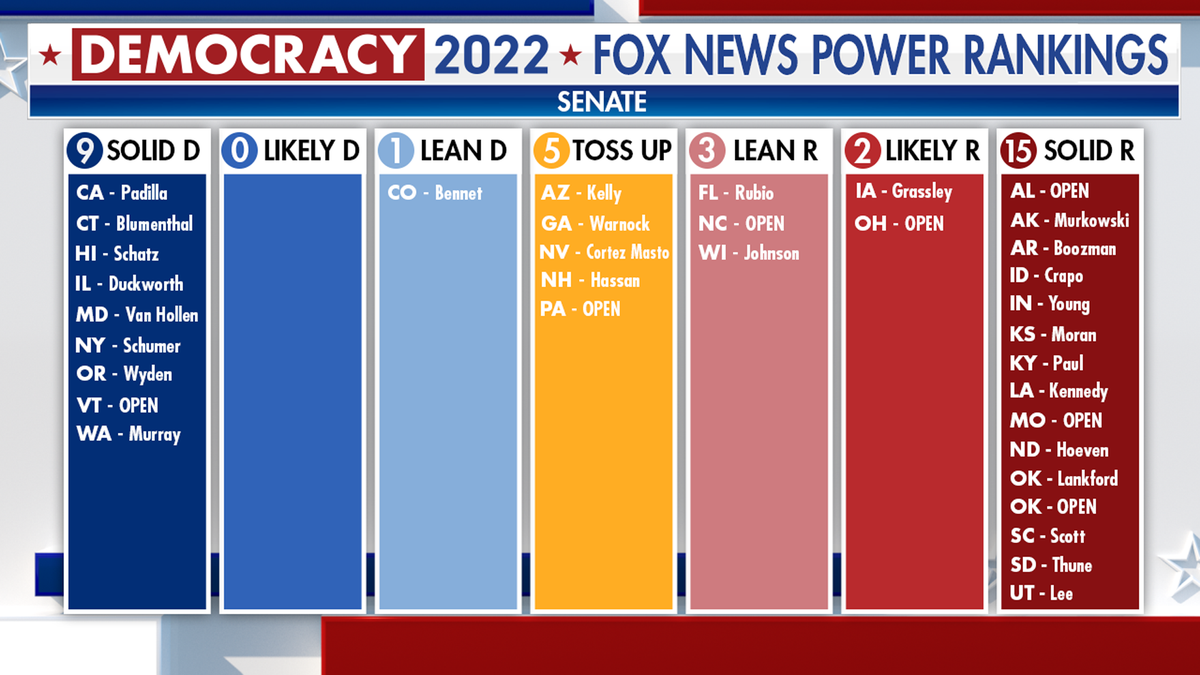
Power Rankings' Senate race table. (Fox News)
While party totals remained in place, three races have changed columns. First, two races in right-leaning states are swapping places. In Missouri, state Attorney General Eric Schmitt’s commanding primary win takes this race out of the competitive columns and into Solid R. In Iowa, Republican Sen. Chuck Grassley is a little more vulnerable after a recent Des Moines Register poll showed the longtime incumbent at 47%. That’s just eight points ahead of his opponent, the retired U.S. Navy admiral and Democrat Mike Franken. His race shifts from Solid R to Likely R.
WHAT ARE THE FOX NEWS POWER RANKINGS?
Meanwhile, Democrats should feel confident about their chances in Washington state. In March, this column noticed Republican challenger Tiffany Smiley’s disciplined campaign against the Democrat, five-term Sen. Patty Murray. Along with Colorado, the Evergreen State offered potential salvation to the GOP, given that their candidates in the East are struggling to gain momentum. But, on Aug. 2, voters in Washington’s nonpartisan primary handed Murray a decisive win, up 19 points versus Smiley. Even after adding every candidate’s vote totals for a rough estimate of party support, the Democrats were still up 14 points. Smiley has not gained enough ground in centrist areas of the state to make this a competitive race in November. Washington moves back from Likely D to Solid D.
Governor: 5 races firm up for the Democrats, while Republicans make gains in New Mexico and Vermont
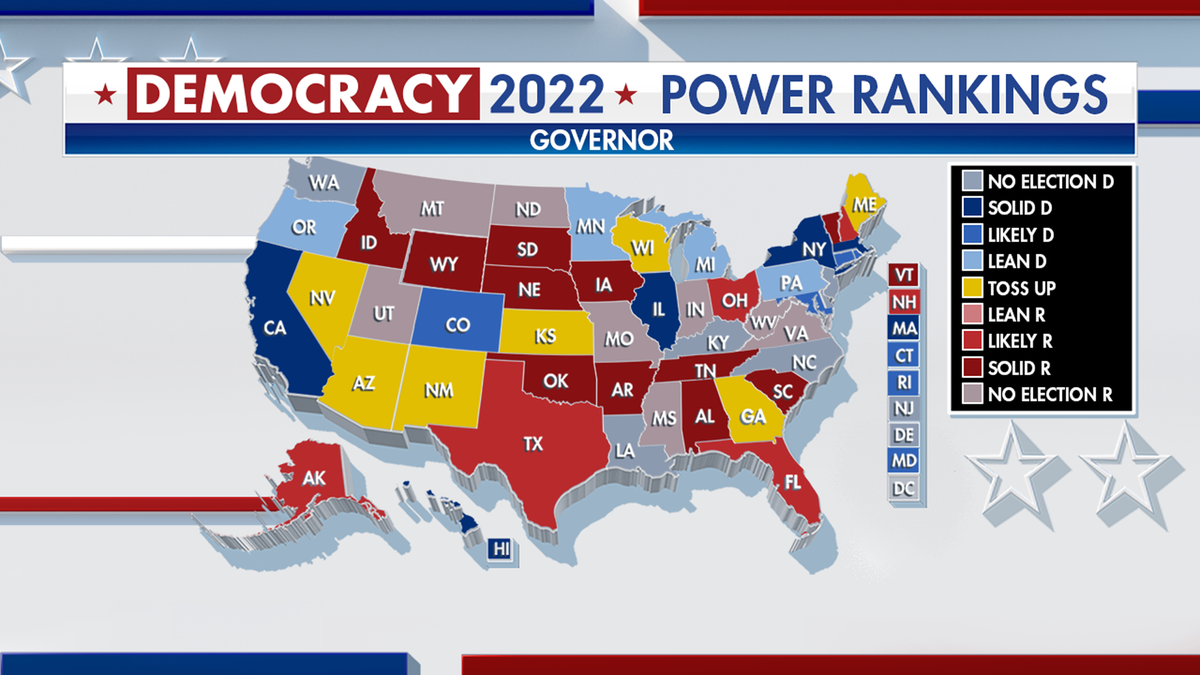
Governor's race predictions for 2022. (Fox News)
Finally, turning to the governor's races, where one state moves out of the GOP columns but the headline numbers are otherwise intact. The key race is Kansas, where moderate incumbent Gov. Laura Kelly will face state Attorney General Derek Schmidt. The rankings previously gave Schmidt a slight edge, and as voters continued to prioritize cost of living above all other issues in recent surveys, he still has every chance of flipping the state red in November. However, as Kansas deals with the fallout from a decisive ballot measure verdict in favor of retaining abortion rights, questions have lingered about Republican enthusiasm in November. Schmidt is largely staying quiet on the issue as election day approaches.
There are four other shifts on the board in favor of Democrats. The first is Michigan, where Republican Tudor Dixon is running a strong but underfunded campaign against vulnerable Gov. Gretchen Whitmer. The first-term incumbent had a $27 million fundraising advantage in late July. Dixon is surely hoping that a cash infusion from the DeVos family will carry weight in the weeks ahead, and this column continues to monitor the race closely. Illinois, Massachusetts and Maryland have all moved a column to the left (to Solid D, Solid D and Likely D, respectively). Former President Trump endorsed far-right candidates in these blue states, and they all went on to win their primaries. They have a much tougher climb in the general.
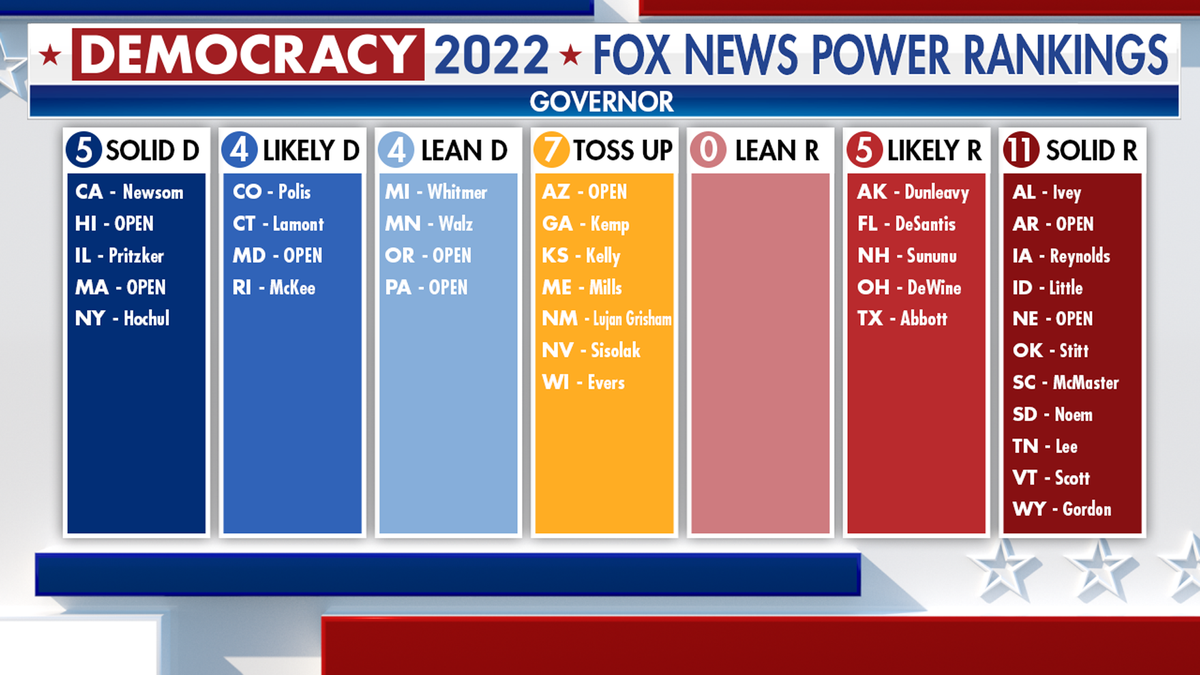
Governor's race table shows several shifts. (Fox News)
There is one bright spot for Republicans in these rankings, and that is in New Mexico. As Josh Kraushaar reported last week, New Mexico is home to a high Hispanic population, a voting bloc shifting rightward. The GOP candidate is former local news anchor Mark Ronchetti. He is appealing to conservatives and moderates by focusing on crime and the economy, while keeping a distance from Trump. Incumbent Gov. Michelle Lujan Grisham, a Democrat, has a $3.4 million fundraising lead as of early July, but polling does not give her a clear edge. New Mexico moves from Lean D to Toss Up.
Republicans can also put to rest fears of Democrats flipping the governor's mansion in Vermont. In a recent University of New Hampshire survey, incumbent Gov. Phil Scott took 60% of the vote, up 44 points against Democrat Brenda Siegel. That puts the race far away from competitive territory. Vermont moves from Likely R to Solid R.
11 weeks to go until election night
Voters in seven states have not yet chosen their major party candidates. On Tuesday night, watch for primaries in Florida and New York, where Republicans have a number of flip opportunities. By September, two highly competitive statewide races remain, both in the northeast. In New Hampshire, Republicans will decide who takes on incumbent Sen. Maggie Hassan in a race that could decide the Senate, and in Rhode Island, incumbent Dan McKee will face his own secretary of state and several other well-funded challengers in a battle for the Democrats' gubernatorial nomination.
CLICK HERE TO GET THE FOX NEWS APP
The remaining special elections in August also offer clarity on the final House balance of power. Two races in New York are scheduled for Aug. 23, and final results from Alaska’s special election for the at-large congressional district are expected in early September.
Stay tuned for live results, breaking news and sharp analysis from our reporters across the country, as Democracy 2022 continues on Fox News Channel.






